End-of-week treats #6
Pachinko landscapes, stones with your name on them, bedrock for when you're falling, chords like tall trees – will you come for a walk with me?
I did a studio visit with a painter I love this week, which was utterly magical (and I’ll tell you more when that comes out). He’s working on giant landscapes featuring characters scrambling over rocks, which made me think, also, of Lynette Yiadom Boakye’s beautiful 2011 painting, Curses (here below).
We spoke about how Frank Auerbach always has his paintings photographed in black and white before deciding whether they’re good enough to show. It’s funny because Auerbach of course has been around a while, and a lot of the monographs on his work are from a time when reproductions in black and white were the cheaper option, an dpublishers would specify on the cover how many colour plates the book contained. See the back cover of Robert Hughes’s 1990 book: “With 254 illustrations, 174 in duotone and 80 in color.”
But that inadvertently matched Auerbach’s process. Still now, at 93, filtering out the colour allows him to see a painting’s graphic structure, its skeleton, how it moves and holds stills and whether it’s strong enough to be set free into the world.
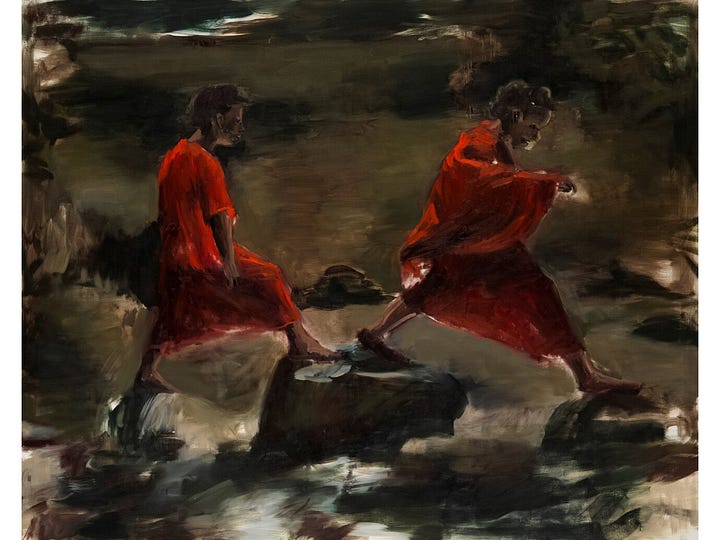
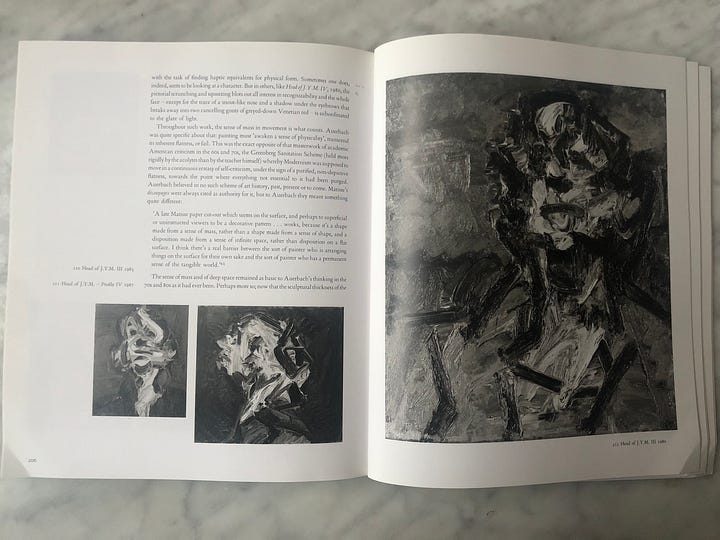
I’m missing my hills.
My long morning walks alone in the trees and then above the tree line, in the rocks. I always come home with a stone or a piece of wood, or a pottery shard. The hills in the Cévennes used to see a lot more footfall than they do these days. Everywhere you find crumbling drystone walls and small structures with caved-in roofs where people used to dry chestnuts and keep sheep. Each walk I go on, I’ll come back with small fragments of old bowls and plates in my pockets and my mother leaves them on the window sill. It’s a beautiful collection, that I will show you one of these days.
My mother has a similar way about her. In her living room, she has a small basket of pebbles on her mantelpiece on which she writes the names of people she holds close in her heart and her prayers. (That always reminds me of my friend Rie, to whom I showed this obsidian Jodie once gave me, and who remarked, “Ah. A stone comes when you need one.” It also reminds me that I need to buy Hettie Judah’s newly republished Lapidarium: The Secret Lives of Stones. 🧊💎📀🪅🔋🔰🛡🚨🔮🎆🔶💥🪩🪨🗿)
Here then, some stones I’ve picked up and kept in my pocket for you this week:
Pachinko season 2 is not quite Pachinko season 1 (on Apple TV+; lead image above), but the cinematography remains breathtaking. Man, the music, the food, the fabrics, the colours, the dialogue, the ACTING, in those first episodes was really quite something. I had inhaled Min Jin Lee’s novel and felt weirdly anxious when it was turned into a TV show, bc how often does that go wrong, you know? But the way Soo Hugh wove the book’s timeline into multiple overlapping storylines was incredible, leaving the story’s depth of emotion undiluted.
Two Marys: Jack sent me these two albums, At The Dam by Mary Lattimore and
Mary Hurrell's debut, Formations, which he thinks are “just stunning” and I totally agree. Hurrell’s Bloom reminds me of Kristin Oppenheim’s She Was Long Gone, which I’m always singing to myself. Also, of a bunch of other things. I’ve added several to today’s Spotify playlist — see below <3 👇👇👇
A remarkable friendship: a two-woman show opens under that title at Alison Jacques next week, with work by Ohio-born Lenore Tawney and Hawaii-born Toshiko Takaezu. After meeting in 1957, these two great dames made work and exchanged ideas for 50 years, living to 100 and 88 respectively. Makes you wish you had had the chance to sit in the studio with them together, and just watch them be. It also makes you grateful for your friends, ie, in my case, you lot. <3
The Rie mentioned above is Rie Nakajima, an amazing sound artist whose work is so quiet and funny and pointed and simple and complex and moving. She is performing with some excellent people on 13 November at Van Gogh House* in South London. “This time, we will use the whole house (bedrooms, staircase, bathroom etc),” she posted on IG, “but it's quite small, so we decided to do two times, 18:30 and 20:00. It can be similar but of course different. As I know any of us cannot do the same things twice...”
Toshimaru Nakamura’s 2000 classic, No-Input Mixing Board.
Fra Angelico’s The Crucifixion with the Virgin, Saint John the Evangelist and the Magdalen is one of those diminutive, ancient works that always stills my mind. It dates back to the 1420s. Look at the greens of the angel’s wings on the right and the perfect silhouette of their counterpart on the left. Look at the swan in the tree above Christ’s head. The tilt of each head as they all look at him and at each other and at us. The perfect simplicity of the composition. “It’s both monumental and moving and simple and complex, and there are even tiny things that show him thinking in new ways about picture making,” said Xa Sturgis, the director of the Ashmolean museum in Oxford, which has just managed to raise the £4.48m needed to acquire it for the British public and stop it being sold abroad.
Another treasure right here in England, courtesy of my father in France. 🤷♀️. When I saw “temperate rainforest” I thought it was going to be about hazelwood and oakwood in Scotland and the Lake District, which I did know about, but no, it’s about the temperate rainforests of Devon, Cornwall and Somerset.
I have been doing research for a piece on my all-time favourite pianist, Robert Glasper, and I found this gem in an early review: Ben Ratliff in the NYT, describing the long single-note runs Glasper played in a live version of Stevie Wonder’s 1972 song, You’ve Got It Bad Girl, “like tall trees falling”.
I told you about Kettle’s Yard the other day. Jim Ede, of course, loved stones too.
That middle stone there, my one Grace Allen told me recently, is called a hag stone. I had no idea. I’ve been collecting them for years and stringing them up in what I like to call house necklaces. Right now, I have one in my kitchen, with stones from Dungeness, a quite extraordinary place on the Kentish coast that we have been going to forever. It’s where the celebrated filmmaker Derek Jarman had his cottage and where Hiraki has often filmed. There’s a nuclear power station (which is being demolished), a military firing range, a bird sanctuary, the tiniest railway***, first and second world war listening ears (sonic mirrors), and the eeriest beach in all of England. Dry wood, rusted metal, huge pebbles, rail tracks, sea kale, wind and tumbleweed, the whole thing is like a film set.
This Jarman interview, from 1987, wherein he talks about Caravaggio …
… which brings me to one of my all-time favourite writers, Teju Cole, and his essay on retracing Caravaggio’s route of exile in 2016, as a device of sorts to reckon with the migration crisis that has claimed so very many lives in the Mediterranean. Black Pages is such an amazing book.
So too, Cole’s photography, the books of which I would very much like to own, in full.
This story, by the wonderful Justin McCurry, about an itinerant blind shamisen player, Rieko Hirosawa. “Her guide dog Sophia at her feet, Hirosawa readies herself for another song: ‘I love coming out here and singing while I’m facing the mountains,’ she says. There is little doubt that the mountains are listening.”
I — because when I’m not in the hills, I am pounding city pavements — have been haunted for too long by someone telling me about a performance artist, a woman, who would harmonise with construction sites. I love that so much. But Google “artist harmonising with construction site” and it’s a weirdly populated group of search terms. So if you know who I mean:
My cousin David, I learned recently, is really into fly fishing. “I keep getting strange requests from him,” my auntie Mary recently emailed, “ranging from saving white cat fur after brushing the cat to a coffee grinder from the 60s.....very specific.” Look at these lures he’s making by hand with those materials:
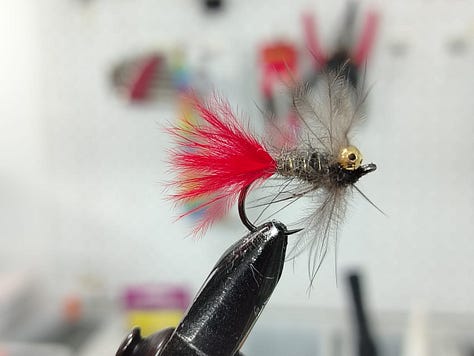
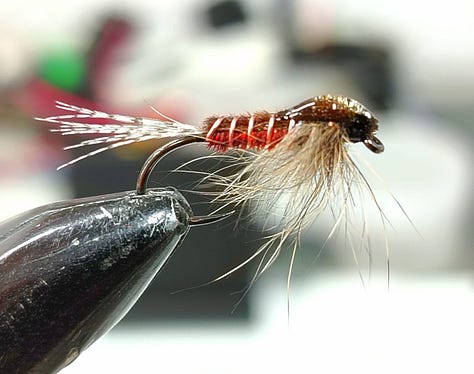
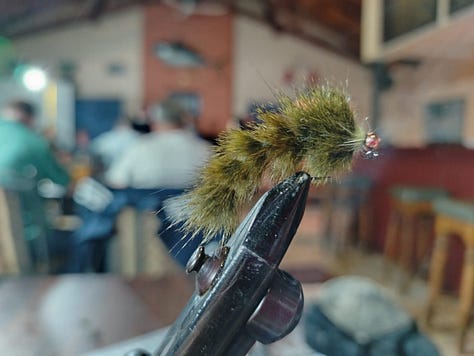
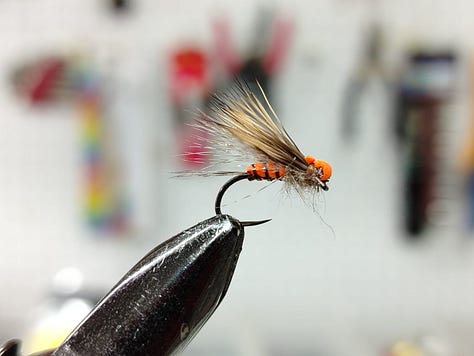

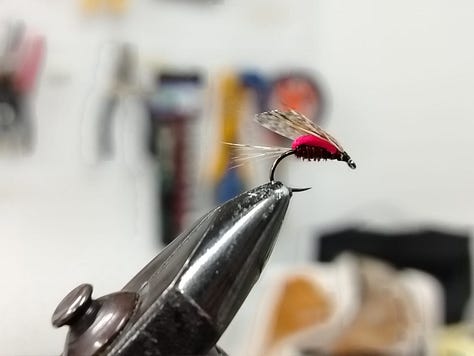
David Jones, fly fishing lures. Of course, that makes me think of this:
“Eventually, all things merge into one, and a river runs through it. The river was cut by the world’s great flood and runs over rocks from the basement of time. On some of the rocks are timeless raindrops. Under the rocks are the words, and some of the words are theirs. I am haunted by waters.”
Norman Maclean, A River Runs Through ItJulien Charrière has a show titled Stone Speakers - Les bruits de la terre (The sounds of the earth) at the Palais de Tokyo until 5 January 2025 in which feature field recordings he made of volcanoes in Colombia, Ethiopia, Iceland, Indonesia and Italy.
This interview with Teedra Moses, who I’ve loved now for 20 years OMG, wherein she talks about the biggest lesson she’s learned: “to stay the course, persevere, continue on, and stick to what you’re doing.” Be bedrock.
Bedrock. A while ago, I wrote this, in a longer thing I might one of these days publish here**:
He fell into a crevasse and the only way he had to climb out or at least to attempt to do so was to abseil down further, to see if there was a bottom and whether he could reach it. He dropped into the dark, unknowing, and he found solid ground. A sandy floor of bedrock.
That feeling is what what God is to me, because I fall in my head with every breath. I’ll be walking down the street or driving through a junction, or switching on a light in a dark corridor, or putting my feet on the floor next to my bed to get up and the frenzy, the madness it is right there, lapping at the edges of my mind – shards of extreme violence piercing my field of vision or thought, a glitch, an electronic faultline, a zone of interference whose pull I can’t escape.
Rats or sharks attacking my sleepy feet. Glass flying everywhere and hitting everyone and everything. Ransack the entire apartment, trash the Sol LeWitt mural, scratch and smash the impeccably varnished surface of the Tomaselli, ram the Landrover into a wall****. Scream.
This doesn’t feel like it has anything to do with desire – it’s more external, involuntary. And I also know it’s not to be actualised by me – I don’t picture myself as the agent of these actions. The glitches are like the activity, whatever that may be, distilled, its essence, a potent precipitate in the solution of my mind. They’re like the chaos dreams I used to have, only those came in the night, whereas these interruptions are daylight creatures.
The chaos dreams used to happen often. I’d wake up exhausted, knowing I’d dreamed something intense, that I could still feel upon waking and for hours afterwards, but it was a phenomenon that eluded speech entirely. I couldn’t say it out loud. I can still feel it now though, 20 years later – a maze of stuff, une morasse, intense sensorial activity, manic interference, sensory overload on overdrive, noise and static on a receiver that won’t tune into anything specific but won’t be turned off either.
Somehow he learned to navigate. He remembered. He climbed.
Notes
*The terrace house where Vincent Van Gogh boarded for a year in 1873-4.
**I’ve got so much stuff I’ve written, fiction and non, that isn’t journalistic. What do you reckon? Do you guys fancy reading any of it?
***It’s called the Romney, Hythe & Dymchurch Railway and it has its own webcam.
****“Remember when you lost your shit and/ Drove the car into the garden/ And you got out and said I'm sorry/ To the vines and no one saw it/ I need my girl/ I need my girl” — one of my favourite lyrics ever, from The National’s I Need My Girl.






Wow, I love that Kristin Oppenheim song, feels like a rare thing to find, thank you!
A cool fly tying story that happened down the road, for your cousin David. I think it ended up being a This American Life story https://www.smithsonianmag.com/science-nature/great-feather-heist-180968408/